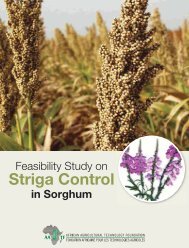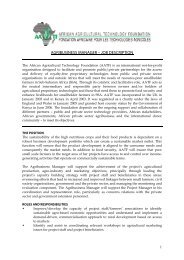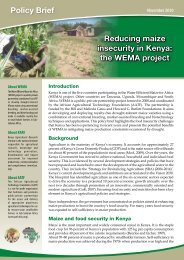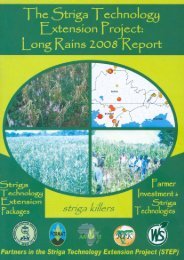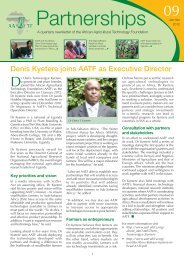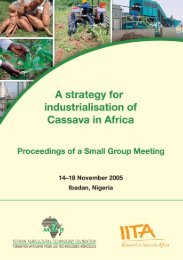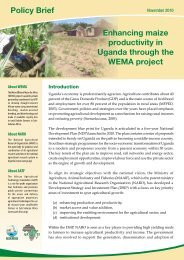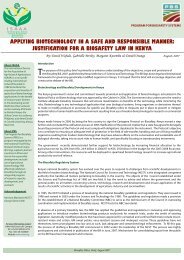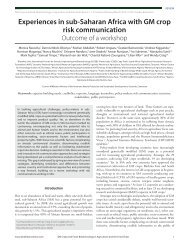Baseline Study of Striga Control using IR Maize in Western Kenya
Baseline Study of Striga Control using IR Maize in Western Kenya
Baseline Study of Striga Control using IR Maize in Western Kenya
You also want an ePaper? Increase the reach of your titles
YUMPU automatically turns print PDFs into web optimized ePapers that Google loves.
SummaryThis report presents the results <strong>of</strong> the basel<strong>in</strong>e study undertaken to assess the status <strong>of</strong> <strong>Striga</strong>damage, the general livelihoods and livelihood strategies <strong>of</strong> the rural poor <strong>in</strong> western <strong>Kenya</strong>.A stratified random sampl<strong>in</strong>g method led to the selection <strong>of</strong> 8 districts, 16 sub-locations, 32villages and 800 households. A comb<strong>in</strong>ation <strong>of</strong> techniques for data collection was used,<strong>in</strong>clud<strong>in</strong>g literature review, GPS record<strong>in</strong>gs, focus group discussions and <strong>in</strong>terview <strong>of</strong><strong>in</strong>dividual households. Various econometric models were also developed and estimated fordata analyses. A stochastic frontier production function was used to measure the technicalefficiency <strong>of</strong> maize production. A logistic regression model <strong>of</strong> poverty was estimated toexam<strong>in</strong>e the determ<strong>in</strong>ants and correlates <strong>of</strong> poverty <strong>in</strong> western <strong>Kenya</strong>.The study revealed that households are small <strong>in</strong> size and the dependency ratio is high. Therewere about 26% <strong>of</strong> households headed by females. The level <strong>of</strong> education is low for the heads<strong>of</strong> households and all members <strong>of</strong> farm families. Households are endowed with a multitude <strong>of</strong>assets for their livelihoods. However, the level <strong>of</strong> assets was found to be low or <strong>of</strong> very poorquality. <strong>Maize</strong> is the major food crop and a source <strong>of</strong> cash <strong>in</strong>come. Farmers grow both localand improved (hybrid) maize varieties, but the productivity is low. There is a considerablegap between potential and actual maize yields. Major factors constra<strong>in</strong><strong>in</strong>g crop production<strong>in</strong>clude <strong>Striga</strong> <strong>in</strong>festation on maize, low soil fertility, drought and erratic ra<strong>in</strong>fall. <strong>Striga</strong> is themajor threat to livelihoods <strong>of</strong> smallholders and its economic importance has <strong>in</strong>creased overthe past three decades. Traditional methods <strong>of</strong> <strong>Striga</strong> control <strong>in</strong>clude uproot<strong>in</strong>g, burn<strong>in</strong>g andmanur<strong>in</strong>g, which have proved to be <strong>in</strong>effective. Alternative technologies exist but they havenot been adopted and used as they should because the level <strong>of</strong> awareness is very low.Analysis <strong>of</strong> the determ<strong>in</strong>ants <strong>of</strong> poverty revealed that the poverty status <strong>of</strong> a household <strong>in</strong>western <strong>Kenya</strong> is significantly related to <strong>Striga</strong> damage, <strong>Striga</strong> control, dependency ratio,age, education, technology adoption, land per capita, farm assets, <strong>of</strong>f-farm work, cash cropproduction, and location.More than 70% <strong>of</strong> the sampled households experience food shortage last<strong>in</strong>g as long as fivemonths every year. Cop<strong>in</strong>g strategies <strong>in</strong>clude <strong>of</strong>f-farm short-term jobs, disposal <strong>of</strong> assets, and<strong>in</strong>formal safety nets especially through remittances received from relatives. Theanthropometric Z scores calculated on children <strong>in</strong>dicate that about 30% were wast<strong>in</strong>g, 50%were underweight and 48% were stunted. Similarly, the results on body mass <strong>in</strong>dex (BMI) onwomen showed that 36% were underweight while 18% were overweight.One <strong>of</strong> the possible strategies to reduce poverty and vulnerability is to <strong>in</strong>crease the efficiency<strong>in</strong> maize production. Considerable variation <strong>in</strong> maize production efficiency was found amongthe sample maize farmers. The results po<strong>in</strong>t to the possibility <strong>of</strong> <strong>in</strong>creas<strong>in</strong>g maize productionthrough improved efficiency and best local practices adopted by the most efficient farmers <strong>in</strong>the sample, such as <strong>in</strong>tegrated <strong>Striga</strong> control. While technical efficiency <strong>in</strong>creases witheducational atta<strong>in</strong>ment, it has a significant non-l<strong>in</strong>ear relationship with farm size where it first<strong>in</strong>creases but eventually decl<strong>in</strong>es with farm size. The direct farm size-efficiency relationshipfor smaller hold<strong>in</strong>gs coupled with the fact that most farmers <strong>in</strong> western <strong>Kenya</strong> cultivate t<strong>in</strong>yplots <strong>of</strong> land suggests that re-allocation <strong>of</strong> more land to maize would enhance farmerefficiency. Increased efficiency could be achieved through, for <strong>in</strong>stance, more optimalapplication <strong>of</strong> <strong>in</strong>puts and greater <strong>in</strong>tensity <strong>of</strong> adoption <strong>of</strong> improved maize varieties. Therefore,efforts must be made to enhance adoption <strong>of</strong> both hybrid maize and <strong>Striga</strong> controltechnologies to help <strong>in</strong>crease maize production. <strong>Maize</strong> yields <strong>in</strong> <strong>Kenya</strong> have cont<strong>in</strong>ued todecl<strong>in</strong>e despite <strong>in</strong>creased use <strong>of</strong> new maize varieties, largely due to lack <strong>of</strong> effective <strong>Striga</strong>6




